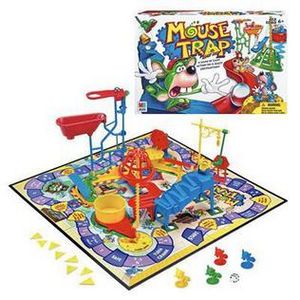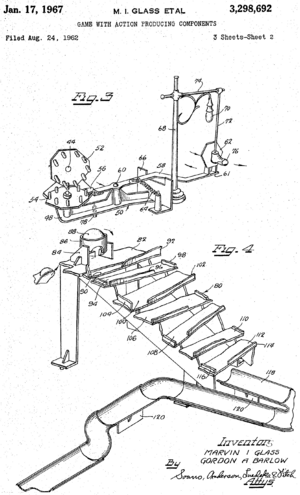Mouse Trap (game) facts for kids

Mouse Trap playing board and box.
|
|
| Publisher(s) | Hasbro |
|---|---|
| Publication date | 1963 |
| Years active | 1963 to present |
| Players | 2–4 |
| Setup time | 5–15 minutes |
| Playing time | 30 minutes |
| Random chance | High (dice rolling game) |
| Skill(s) required | Finger dexterity |
Mouse Trap is a super fun board game that first came out in 1963. It was made by the Ideal Toy Company. This game is special because it was one of the first board games ever made that was three-dimensional!
In Mouse Trap, players first work together. Their goal is to build a cool, complicated machine. This machine is like a Rube Goldberg machine, which is a device that uses a chain reaction to do a simple task. Once the big mouse trap machine is built, the game changes. Players then try to trap each other's mouse-shaped game pieces!
Contents
How to Play Mouse Trap
The main idea of Mouse Trap has stayed the same over the years. But how you play your turn has changed a bit.
The Original Game
The first Mouse Trap game came out in 1963. It was designed by Hank Kramer. In this version, players don't make many choices. It's a lot like other simple games for younger kids, such as Candyland or Chutes and Ladders.
Players take turns rolling a dice. They move their mouse piece along a path on the game board. The path goes from the start all the way to a loop at the end. The big mouse trap machine is built in the middle of the board. Players add parts to the trap when they land on special "build" spaces. The trap always gets built in a certain order. Its pieces snap into holes on the board.
On the ending loop of the board, there are more "build" spaces. These are there in case the trap isn't finished yet. There's also a "cheese" space right under the trap's cage. And there's a "turn crank" space. If a player lands on the "turn crank" space, and another player is on the "cheese" space, they can turn the crank! This makes the machine launch and trap the opponent. The last player left in the game wins!
Newer Versions of the Game
Over the years, Mouse Trap has been updated several times.
In 1975, the game board was changed. New "cheese pieces" were added. These let players move opponents onto the trap space. If the trap space was empty when you landed on "turn crank," you could use your cheese tokens. You'd roll the dice again to move an opponent onto the trap.
A different version came out in the United Kingdom in 2004. This one had three mousetraps! It also had a special trigger that worked randomly. The board and plastic parts were completely different. This version even had a model toilet as part of the trap, instead of a bathtub!
In 2014, a version with characters from the Elefun and Friends cartoon came out. In this game, the trap is built before the game even starts. Players use a spin wheel instead of dice. Also, the cheese pieces and their rules are not included in this version.
Around the 2010s, Hasbro released Classic Mousetrap. This version had some big changes. The goal is to collect six cheese pieces. If a player gets caught by the trap, they don't get kicked out of the game. Instead, they just lose one cheese piece to the opponent. The trap machine was also changed. For example, you launch the trap by pulling a lever directly, instead of turning crank gears.
Games Like Mouse Trap
| Manufacturer(s) | Ideal Toy Company |
|---|---|
| Publisher(s) | Ideal Toy Company |
| Publication date | 1964 |
| Genre(s) | Roll-and-move, cards |
| Players | 2–4 |
| Setup time | 15 min |
| Playing time | 30 min |
| Synonym(s) | Crazy Clock |
| Manufacturer(s) | Ideal Toy Company |
|---|---|
| Publisher(s) | Ideal Toy Company |
| Publication date | 1965 |
| Genre(s) | Roll-and-move |
| Players | 2–4 |
| Playing time | 15 min |
| Synonym(s) | Fish Bait |
The game designer Marvin Glass created Mouse Trap. He said that the game was inspired by the drawings of Rube Goldberg. Rube Goldberg was famous for drawing very complicated machines that did simple things. Marvin Glass later made two other games based on Goldberg's ideas: Crazy Clock Game (1964) and Fish Bait Game (1965).
Crazy Clock Game
In Crazy Clock Game, players race to build a Rube Goldberg machine. The game comes with cards. Each card shows how one part of the machine fits together. Players get a deck of these cards. They start with the first card and try to play as many cards as they can. This means they install as many machine parts as possible. Then, it's the next player's turn. After the machine is fully built, players take turns trying to make it work. The first player to successfully operate the machine wins!
Fish Bait Game
Fish Bait Game is a bit simpler than Mouse Trap. In this game, players pretend to be fishermen. They build a contraption to catch a big, hungry man-eating fish. Every time a player lands on an empty white space, they have to build a part of the contraption. Other spaces on the board can give you an extra turn, make you lose a turn, or send you back a space.
The game continues until the contraption is fully built. Then, a player lands on the "FISH BAIT" space. When this happens, the player puts their game piece on a plastic dock. They hook a rubber band from inside the fish's mouth around the legs of their piece. Players keep moving until someone lands on the "CATCH FISH" space. This player starts the contraption to try and catch another player's piece. If your piece gets caught, you're out of the game! (But if the trap fails, the players switch places until someone is caught). The game keeps going until only one player is left. That player is the winner!
Mouse Trap in Pop Culture
Mouse Trap has become quite famous!
In the 1990s, Mouse Trap was even turned into a game show. It was part of a British children's TV show called Motormouth. In the show, kids became the "mice" and played on a giant, life-sized version of the board game!
A group in San Francisco created a huge, traveling show called Life Size Mouse Trap. It's a giant version of the game. Instead of trapping a small mouse, this huge machine drops a giant old bank safe onto a car! It's an amazing piece of engineering. People say it's a great way to learn about physics and simple machines.


